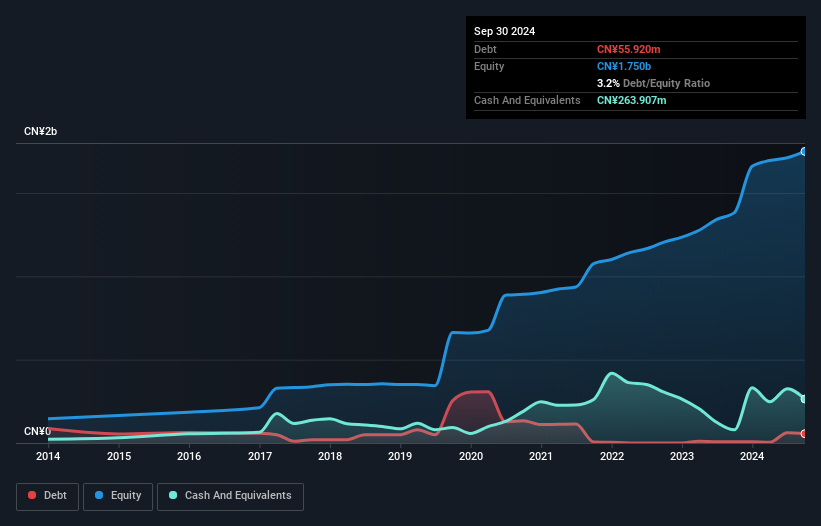David Iben put it well when he said, 'Volatility is not a risk we care about. What we care about is avoiding the permanent loss of capital.' So it might be obvious that you need to consider debt, when you think about how risky any given stock is, because too much debt can sink a company. We note that Guangdong Kingstrong Technology Co., Ltd. (SZSE:300629) does have debt on its balance sheet. But should shareholders be worried about its use of debt?
Why Does Debt Bring Risk?
Generally speaking, debt only becomes a real problem when a company can't easily pay it off, either by raising capital or with its own cash flow. If things get really bad, the lenders can take control of the business. However, a more usual (but still expensive) situation is where a company must dilute shareholders at a cheap share price simply to get debt under control. Of course, the upside of debt is that it often represents cheap capital, especially when it replaces dilution in a company with the ability to reinvest at high rates of return. The first step when considering a company's debt levels is to consider its cash and debt together.
What Is Guangdong Kingstrong Technology's Debt?
The image below, which you can click on for greater detail, shows that at September 2024 Guangdong Kingstrong Technology had debt of CN¥55.9m, up from CN¥7.23m in one year. However, its balance sheet shows it holds CN¥263.9m in cash, so it actually has CN¥208.0m net cash.

A Look At Guangdong Kingstrong Technology's Liabilities
 We can see from the most recent balance sheet that Guangdong Kingstrong Technology had liabilities of CN¥182.8m falling due within a year, and liabilities of CN¥144.1m due beyond that. On the other hand, it had cash of CN¥263.9m and CN¥965.7m worth of receivables due within a year. So it actually has CN¥902.7m more liquid assets than total liabilities.
We can see from the most recent balance sheet that Guangdong Kingstrong Technology had liabilities of CN¥182.8m falling due within a year, and liabilities of CN¥144.1m due beyond that. On the other hand, it had cash of CN¥263.9m and CN¥965.7m worth of receivables due within a year. So it actually has CN¥902.7m more liquid assets than total liabilities.
This surplus suggests that Guangdong Kingstrong Technology is using debt in a way that is appears to be both safe and conservative. Because it has plenty of assets, it is unlikely to have trouble with its lenders. Succinctly put, Guangdong Kingstrong Technology boasts net cash, so it's fair to say it does not have a heavy debt load!
Also good is that Guangdong Kingstrong Technology grew its EBIT at 12% over the last year, further increasing its ability to manage debt. When analysing debt levels, the balance sheet is the obvious place to start. But it is Guangdong Kingstrong Technology's earnings that will influence how the balance sheet holds up in the future. So if you're keen to discover more about its earnings, it might be worth checking out this graph of its long term earnings trend.
But our final consideration is also important, because a company cannot pay debt with paper profits; it needs cold hard cash. Guangdong Kingstrong Technology may have net cash on the balance sheet, but it is still interesting to look at how well the business converts its earnings before interest and tax (EBIT) to free cash flow, because that will influence both its need for, and its capacity to manage debt. Over the last three years, Guangdong Kingstrong Technology saw substantial negative free cash flow, in total. While that may be a result of expenditure for growth, it does make the debt far more risky.
Summing Up
While it is always sensible to investigate a company's debt, in this case Guangdong Kingstrong Technology has CN¥208.0m in net cash and a decent-looking balance sheet. And it also grew its EBIT by 12% over the last year. So we don't have any problem with Guangdong Kingstrong Technology's use of debt. The balance sheet is clearly the area to focus on when you are analysing debt. But ultimately, every company can contain risks that exist outside of the balance sheet. These risks can be hard to spot. Every company has them, and we've spotted 1 warning sign for Guangdong Kingstrong Technology you should know about.
At the end of the day, it's often better to focus on companies that are free from net debt. You can access our special list of such companies (all with a track record of profit growth). It's free.
Have feedback on this article? Concerned about the content? Get in touch with us directly. Alternatively, email editorial-team (at) simplywallst.com.
This article by Simply Wall St is general in nature. We provide commentary based on historical data and analyst forecasts only using an unbiased methodology and our articles are not intended to be financial advice. It does not constitute a recommendation to buy or sell any stock, and does not take account of your objectives, or your financial situation. We aim to bring you long-term focused analysis driven by fundamental data. Note that our analysis may not factor in the latest price-sensitive company announcements or qualitative material. Simply Wall St has no position in any stocks mentioned.

